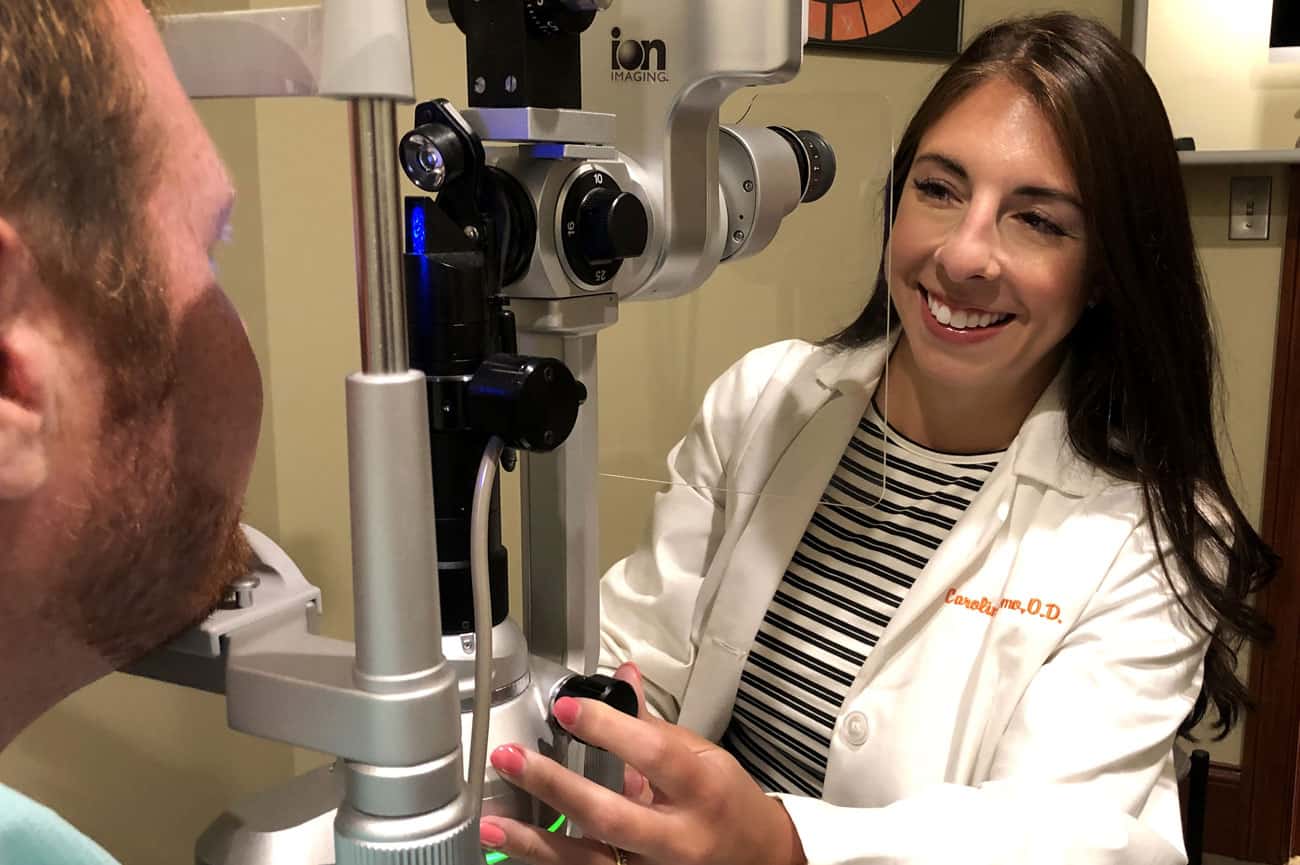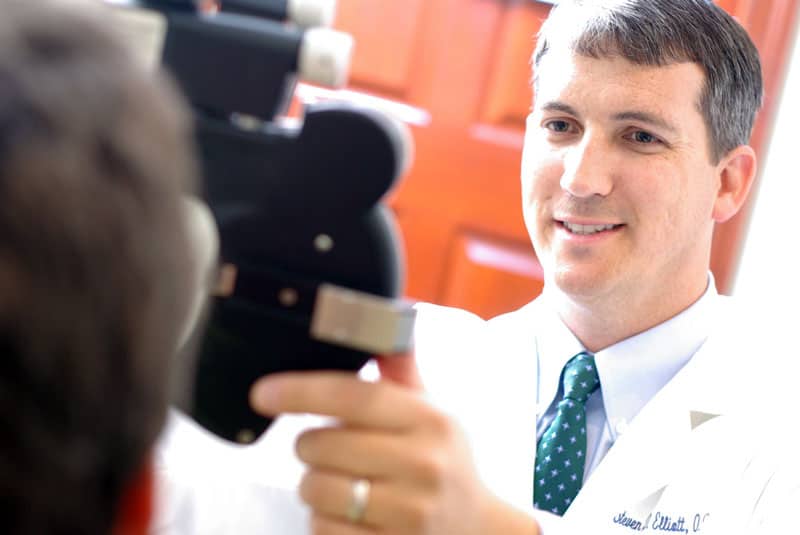
Adult Eyecare
Young Adults: 19 to 40 Years of Age
The AOA recommends that adults aged 19 to 40 receive an eye exam at least every two years. Most adults between the ages of 19 and 40 enjoy healthy eyes and good vision. The most common eye and vision problems for people in this age group are due to visual stress and eye injuries. By maintaining a healthy lifestyle and protecting your eyes from stress and injury, you can avoid many eye and vision problems.
Good vision is important as you pursue a college degree, begin your career, or perhaps start and raise a family. Here are some things you can do to maintain healthy eyes and good vision:
- Protect your eyes from short-wavelength visible light. Most digital devices and newer LED and fluorescent lights emit more wavelengths near the shorter, or bluer, part of the spectrum. High and continual exposure to these wavelengths can cause slow damage to the retina, which may result in problems like age-related macular degeneration later in life. Special glasses and lens coatings are available to block short-wavelength visible light.
- Protect your eyes from the sun. The sun emits harmful ultraviolet (UV) rays that can damage your eyes over the long term. Choose sunglasses with UV-A and UV-B protection with adequate coverage. Additionally, use sunscreen around the delicate skin around your eyes, and wear a hat or visor in addition to sunglasses to improve protection.
- Don’t smoke. Smoking exposes your eyes to high levels of noxious chemicals and increases the risk for developing age-related macular degeneration (AMD) and cataracts.
- Eat a balanced diet. As part of a healthful diet, eat five servings of fruits and vegetables each day. Choose foods rich in antioxidants, like leafy, green vegetables and fish.
- Get regular exercise. Exercise improves blood circulation, increases oxygen levels to the eyes and helps remove toxins.
- Get an eye examination annually. Although vision generally remains stable during these years, problems may develop without any obvious signs or symptoms. The best way to protect your vision is through regularly scheduled professional eye examinations.
The American Optometric Association recommends that adults aged 19 to 40 receive an eye exam at least every two years. If you are at risk for eye problems due to a family history of eye disease, diabetes, high blood pressure or past vision problems, your doctor of optometry may recommend more frequent exams. In between examinations, contact your doctor if you notice a change in your vision. Detecting and treating problems early can help maintain good vision for the rest of your life.
Dealing with Visual Stress at School or on the Job

Eyestrain is common in today’s visually demanding world. A typical college schedule or office workday involves long hours reading, working at a desk or staring at a computer. A poorly designed study or work environment that includes improper lighting, uncomfortable seating, incorrect viewing angles and improper reading or working distances can add to the visual stress. As the day progresses, the eyes begin to fatigue, and eyestrain and discomfort can develop.
The following are key signs of eyestrain:
- Sore or tired eyes
- Itching or burning sensations in the eyes
- Sensitivity to light
- Dry or watery eyes
- Headaches
- Difficulty focusing
Here are some simple steps you can take to minimize eyestrain, particularly during computer work:
- Adjust your computer in your work space. Position the top of your computer monitor below eye level so you look slightly downward at the screen. This will help minimize strain on the eyes and the neck. If you are typing from copy, position the text at the same level as the screen. Adjust the screen brightness so it is most comfortable for you. Avoid glare on the computer screen by wearing anti-reflective lenses, adjusting window curtains or blinds, repositioning the monitor or using a glare reduction filter on your screen. Wear special glasses or lens coatings that block short-wavelength visible light if you use digital devices for many hours during the day.
- Use proper lighting. Examine the lighting in your work area. Overhead lights can be harsh and often are brighter than necessary. Consider turning off some lights for a more comfortable lighting situation. Use an adjustable shaded lamp to provide specific task lighting as needed.
- Take rest breaks. Use the 20-20-20 rule. Every 20 minutes, look 20 away for 20 seconds. This allows your eyes to readjust. Consider standing up and walking around or doing alternate tasks that do not require extensive near focusing. Blink often to refresh the eyes and use artificial tear solutions, if necessary.
- Maintain proper posture. When seated at a desk, make sure your feet are flat on the floor. Use an adjustable chair that provides adequate support for your back. When working at a computer, your arms should form a 90-degree angle at the elbows, and your hands should be tilted up slightly to allow your fingers to travel freely over the keyboard.
Making these simple adjustments to your study or work area can do a lot to prevent or reduce eyestrain. If you continue to experience eye-related symptoms, you may have a vision problem that requires treatment. Ask your optometrist.
Adults: 41 to 60 Years of Age
The AOA recommends that adults aged 41 to 60 receive an eye exam at least every two years. Beginning in the early to mid-40s, many adults may start to have problems seeing clearly at close distances, especially when reading and working on the computer. This is among the most common problems adults develop between ages 41 to 60. This normal change in the eye’s focusing ability, called presbyopia, will continue to progress over time.
 Initially, you may need to hold reading materials farther away to see them clearly. Or you may need to remove your glasses to see better up close. Print in the newspaper or on a restaurant menu may appear blurred, especially under dim lighting.
Initially, you may need to hold reading materials farther away to see them clearly. Or you may need to remove your glasses to see better up close. Print in the newspaper or on a restaurant menu may appear blurred, especially under dim lighting.
If you already wear prescription glasses or contact lenses to see clearly in the distance, these changes in your near vision can be corrected by switching to bifocal or multifocal lenses. Fortunately, people with presbyopia now have many options to improve their vision.
During these years, schedule a comprehensive eye examination with your optometrist at least every two years to check for developing eye and vision problems. Don’t rely on the limited driver’s license vision test or other insufficient vision screenings to determine if you have an eye or vision problem.
Adults over 40 who have the following health or work issues may be particularly at risk for developing eye and vision problems:
- Chronic, systemic conditions such as diabetes or high blood pressure.
- A family history of glaucoma or macular degeneration.
- A highly visually demanding job or work in an eye-hazardous occupation.
- Health conditions related to high cholesterol, thyroid, anxiety or depression, and arthritis for which you take medications. Many medications, even antihistamines, have vision side effects.
Understanding Age-related Vision Changes
Just like your body, your eyes and vision change over time. While not everyone will experience the same symptoms, the following are common age-related vision changes:
- Need for more light. As you age, you need more light to see as well as you used to. Brighter lights in your work area or next to your reading chair will help make reading and other close-up tasks easier.
- Difficulty reading and doing close work. Printed materials can become less clear, in part because the lens in your eye becomes less flexible over time. This makes it harder for your eyes to focus on near objects than when you were younger.
- Problems with glare. When driving, you may notice additional glare from headlights at night or sun reflecting off windshields or pavement during the day. Changes in your lenses in your eyes cause light entering the eye to be scattered rather than focused precisely on the retina. This creates more glare.
- Changes in color perception. The normally clear lens located inside your eye may start to discolor. This makes it harder to see and distinguish between certain color shades.
- Reduced tear production. With age, the tear glands in your eyes will produce fewer tears. This is particularly true for women experiencing hormone changes. As a result, your eyes may feel dry and irritated. Having an adequate amount of tears is essential for keeping your eyes healthy and for maintaining clear sight.
Encountering Problems with Near Vision after 40
 If you have never needed eyeglasses or contact lenses to correct distance vision, then experiencing near vision problems after age 40 can be concerning and frustrating. You may feel like you’ve abruptly lost the ability to read the newspaper or see the cell phone numbers.
If you have never needed eyeglasses or contact lenses to correct distance vision, then experiencing near vision problems after age 40 can be concerning and frustrating. You may feel like you’ve abruptly lost the ability to read the newspaper or see the cell phone numbers.
Actually, these changes in your focusing power have been occurring gradually since childhood. Now your eyes don’t have enough focusing power to see clearly for reading and other close vision tasks.
Losing this focusing ability for near vision, called presbyopia, occurs because the lens inside the eye becomes less flexible. This flexibility allows the eye to change focus from objects that are far away to objects that are close. People with presbyopia have several options to regain clear near vision. They include:
- Eyeglasses, including single vision reading glasses and multifocal lenses
- Contact lenses, including monovision and bifocal lenses
- Laser surgery and other refractive surgery procedures
As you continue to age, presbyopia becomes more advanced. You may notice that you need to change your eyeglass or contact lens prescriptions more frequently than you used to. Around age 60, these changes in near vision should stop, and prescription changes should occur less frequently.
Presbyopia can’t be prevented or cured, but most people should be able to regain clear, comfortable near vision for all of their lifestyle needs.
Warning Signs of Eye Health Problems
This is also the time in life when your risk for developing a number of eye and vision problems increases. The following symptoms could be the early warning signs of a serious eye health problem:
- Fluctuating vision. Frequent changes in how clearly you can see may be a sign of diabetes or hypertension (high blood pressure). These chronic conditions can damage the tiny blood vessels in the retina, the light-sensitive layer at the back of the eye. This vision loss can sometimes be permanent.
- Seeing floaters and flashes. Occasionally, you may see spots or floaters in your eyes. In most cases, these are shadowy images of particles floating in the fluid that fills the inside of the eye. Although they can be bothersome, spots and floaters typically don’t harm vision. They are a natural part of the eye’s aging process.
But if you suddenly see more floaters than normal, along with bright, flashing lights, see your optometrist immediately. This could be a sign that you have a tear in your retina, and it could detach. This should be treated immediately to prevent serious loss of vision. - Loss of side vision. Losing peripheral or side vision may be a sign of glaucoma. Glaucoma occurs when the optic nerve is damaged and no longer transmits all visual images to the brain. It often has no symptoms until damage to your vision has begun.
- Seeing distorted images. Straight lines that appear distorted or wavy or an empty area in the center of your vision could be signs of age-related macular degeneration (AMD). The disease affects the macula, which is the part of your retina that is responsible for central vision. The disease causes a blind spot in the middle of your field of vision.
Regular eye examinations and early diagnosis and treatment of eye diseases can help you preserve good vision throughout your life.
Seniors: Over 60 Years of Age
The AOA recommends annual eye examinations for everyone over age 60. Regular eye exams are even more important as you reach your senior years. See your doctor of optometry immediately if you notice any changes in your vision.
Vision changes occur as you get older, but these changes don’t have to affect your lifestyle. Knowing what to expect and when to seek professional care can help you safeguard your vision.
As you reach your 60s and beyond, you need to be aware of the warning signs of age-related eye health problems that could cause vision loss. Many eye diseases have no early symptoms. They may develop painlessly, and you may not notice the changes to your vision until the condition is quite advanced. Wise lifestyle choices, regular eye exams and early detection of disease can significantly improve your chances of maintaining good eye health and vision as you age.
You may not realize that health problems affecting other parts of your body can affect your vision as well. People with diabetes or hypertension (high blood pressure), or who are taking medications that have eye-related side effects, are at greatest risk for developing vision problems.

Age-related Eye and Vision Problems
In the years after you turn 60, a number of eye diseases may develop that can change your vision permanently. The earlier these problems are detected and treated, the more likely you can retain good vision.
The following are some vision disorders to be aware of:
- Age-related macular degeneration (AMD) is an eye disease that affects the macula (the center of the light-sensitive retina at the back of the eye) and causes central vision loss. Although small, the macula is the part of the retina that allows us to see fine detail and colors. Activities like reading, driving, watching TV and recognizing faces all require good central vision provided by the macula. While macular degeneration decreases central vision, peripheral or side vision remains unaffected.
- Cataracts are cloudy or opaque areas in the normally clear lens of the eye. Depending upon their size and location, they can interfere with normal vision. Usually cataracts develop in both eyes, but one may be worse than the other. Cataracts can cause blurry vision, decreased contrast sensitivity, decreased ability to see under low light level conditions (such as when driving at night), dulling of colors and increased sensitivity to glare.
- Diabetic retinopathy is a condition that occurs in people with diabetes. It is the result of progressive damage to the tiny blood vessels that nourish the retina. These damaged blood vessels leak blood and other fluids that cause retinal tissue to swell and cloud vision. The condition usually affects both eyes. The longer a person has diabetes, the greater the risk for developing diabetic retinopathy. In addition, the instability of a person’s glucose measurements over time can impact the development and/or severity of the condition. At its most severe, diabetic retinopathy can cause blindness.
- Dry eye is a condition in which a person produces too few or poor-quality tears. Tears maintain the health of the front surface of the eye and provide clear vision. Dry eye is a common and often chronic problem, particularly in older adults.
- Glaucoma is a group of eye diseases characterized by damage to the optic nerve resulting in loss of peripheral (side) vision. It often affects both eyes, typically one eye before the other. If left untreated, glaucoma can lead to total blindness. People with a family history of glaucoma, African Americans and older adults have a higher risk of developing the disease. Glaucoma is often painless and can have no obvious symptoms until there is a significant loss of side vision.
- Retinal detachment is a tearing or separation of the retina from the underlying tissue. Retinal detachment most often occurs spontaneously due to changes to the gel-like vitreous fluid that fills the back of the eye. Other causes include trauma to the eye or head, health problems like advanced diabetes, and inflammatory eye disorders. If not treated promptly, it can cause permanent vision loss.
Driving Safely After 60
If you are 60 or older, driving a car may be increasingly difficult. Age-related vision changes and eye diseases can negatively affect your driving abilities, even before you are aware of symptoms. Some age-related vision changes that commonly affect seniors’ driving are:
- Not being able to see road signs as clearly
- Difficulty seeing objects up close, like the car instrument panel or road maps
- Difficulty judging distances and speed
- Changes in color perception
- Problems seeing in low light or at night
- Difficulty adapting to bright sunlight or glare from headlights
- Experiencing a loss of side vision
These tips can help you stay safe when driving, especially at night:
- Use extra caution at intersections. Many collisions involving older drivers occur at intersections due to a failure to yield, especially when taking a left turn. Look carefully in both directions before proceeding into an intersection. Turn your head frequently when driving to compensate for any decreased peripheral vision.
- Reduce your speed and limit yourself to daytime driving. If you are having trouble seeing at night or your eyes have difficulty recovering from the glare of oncoming headlights, slow down and avoid driving at night.
- Avoid wearing eyeglasses and sunglasses with wide frames or temples. Glasses with wide temples (side arms) may restrict your side vision.
- Take a driving course for seniors. Participate in a program for older drivers in your community, such as those offered by the American Association of Retired Persons (AARP). This can help you learn how to compensate for the physical changes that may affect your driving ability, and may even lower your insurance premium.
- Have an annual eye examination. Yearly eye exams can ensure your eyeglass or contact lens prescription is up to date. It can also ensure early detection and treatment of any developing eye health problem.

Dealing with Vision Loss
Unfortunately, some people over 60 lose sight beyond the normal, age-related vision changes. Macular degeneration, glaucoma and diabetic retinopathy are among the eye health conditions that can lead to permanent vision loss in varying degrees and forms.
Visual acuity alone is not a good predictor of a person’s degree of visual difficulty. Someone with relatively good acuity (e.g., 20/40) can have difficulty functioning, while someone with worse acuity (e.g., 20/100) might not experience any significant functional problems. Other visual factors, such as poor depth perception, limited side vision, extreme sensitivity to lights and glare, and reduced color perception, can also limit a person’s ability to do everyday tasks.
Low-vision rehabilitative services can provide people with the help and resources they need to regain their independence. These services can teach people with low vision a variety of techniques that allow them to perform daily activities with their remaining vision.
Your doctor of optometry can help plan a rehabilitation program so that you can live an independent life within your condition’s limitations. A wide variety of rehabilitation options are available to help people with low vision live and work more effectively, efficiently and safely. Most people benefit from one or more low-vision treatment options. The more commonly prescribed devices are:
- Spectacle-mounted magnifiers. A magnifying lens is mounted in spectacles (this type of system is called a microscope) or on a special headband. This allows you to use both hands to complete a close-up task, such as writing a letter.
- Handheld or spectacle-mounted telescopes. These miniature telescopes help people see at longer distances, such as across the room to watch television. They can also be modified for near (reading) tasks.
- Handheld and stand magnifiers. These are often portable and convenient for short-term reading tasks, such as viewing price tags, labels and instrument dials. Both types can include lights.
- Video magnification. Table-top (closed-circuit television) or head-mounted systems enlarge reading material on a video display. Some systems can be used for distance viewing. Some are portable systems, and some can be used with a computer or monitor. Users can customize image brightness, image size, contrast, foreground/background color, and illumination.
In addition, numerous other products can assist those with a vision impairment, such as large-type books, magazines, and newspapers; books on tape; talking wristwatches; self-threading needles; and more. Talk with your optometrist to learn more about your available options.

We believe that there is so much more to a eye exam than just an accurate glasses prescription. Why? Our eyes and visual system can produce very similar symptoms. For example, blurred vision can be caused by something as simple as an uncorrected refractive error or as serious as uncontrolled hypertension, diabetes, or even a brain tumor.
Because of this, during our comprehensive eye and vision exam, we thoroughly evaluate the function and health of the eyes and total visual system to obtain ample information to diagnose the cause of signs noted by our doctors or symptoms reported by our patients. In addition, potentially blinding conditions such as glaucoma or diabetic retinopathy may cause no symptoms until they are far advanced and the damage is irreparable. That’s why we dilate the majority of our patient’s eyes to allow us to look at all of the ocular structures to identify the presence of any conditions that may exist without symptoms.
We incorporate the latest technology and rely on thorough objective examination of the eyes to ensure that all eye and related systems are evaluated. At the conclusion of the comprehensive vision exam, we take time to thoroughly explain all of our findings, make recommendations, and answer any questions you may have.
Our adult eye and vision examination includes:
- Dilation, as necessary, to help view the internal structures of the eye.
- General health screening of physical conditions and prescription medications that may affect your eyesight.
- Evaluation of current glasses prescriptions
- Visual acuity measurement and refraction to determine the degree to which you may be nearsighted, farsighted, presbyopic or have astigmatism.
- Muscle test to identify any muscle weakness or involuntary eye movement.
- Binocular vision skills assessment to assure your eyes work together as a team; important for proper depth perception, eye muscle coordination, detection of lazy eye conditions including strabismus and amblyopia, and the ability to change focus from near to far objects.
- Applanation tonometry to measure internal eye pressure and detect glaucoma.
- A comprehensive internal and external eye health assessment using the latest technologies to evaluate all anterior segment aspects of the eye and all posterior segments of the eye.
Other testing may include:
- Visual field test to measure peripheral vision and detect diseases of the eyes or neurological disorders.
- Color vision screening for color perception and neurologic evaluation.
- Stereopsis or depth perception evaluation.
- Gonioscopy or anterior segment evaluation.
- Pachymetry to measure corneal thickness to aid in the diagnosis of glaucoma.
- Digital retinal photography.
- Screening blood pressure testing.
- Glucose tolerance


